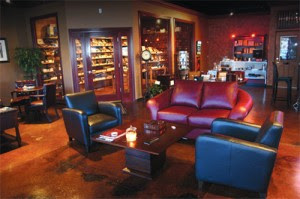With Father’s Day approaching, it might be a good time to help dad indulge in the time-honored experience of puffing on an expertly rolled cigar. While popular sentiment and government bans sometimes make it necessary to take pains to enjoy a good smoke, the experience can still be rewarding.
Consider the quiet joy that can be found during a long walk down a country road alone, save for one’s favorite cigar. Don’t know enough about cigars to feel confident buying them? The Capital District shops noted here have friendly, knowledgeable staffers ready to help shoppers make the right choice, no matter what their level of tobacco knowledge.
Selecting the right cigar
“Cigar-smoking is highly individual and subjective,” says Scott Bendett, founder and proprietor of Habana Premium Cigar Shoppe in Albany. “It’s a matter of taste.”
If you don’t know what you’re looking for, Bendett or a staff member can make suggestions. Habana Premium features numerous brands, a walk-in humidor and cigars flavored with vanilla, rum, cappuccino, honey and mandarin.
“We love talking with gift shoppers to help them make a good selection,” says Rich Albers, assistant manager at Park Lane Tobacconist in Clifton Park. “There’s no reason to feel intimidated.”
According to Albers, things to consider include how long the person has been smoking; if they prefer a mild or robust cigar, in a large or small size; and if they have a brand preference.
“The occasional smoker generally wants a milder cigar,” says John Zyniecki, coproprietor of EdLeez Tobacco in Albany. “The regular smoker usually likes a more flavorful cigar.”
When buying cigars for a special occasion, Zyniecki says most shoppers choose a “limited cigar,” such as an Opus X. Ranging in price from $15 to $20 per cigar, these are typically the items most smokers appreciate but do not regularly buy for themselves and are made in limited quantities. Brands such as Ashton, Arturo Fuente, CAO, Camacho, Davidoff, Cusano and Macanudo also make high-end cigars.
Cigar talk
The cigar world has a vocabulary all its own, and a good tobacconist should be able to explain the points of a cigar’s three main components: wrapper, filler and binder. While some machine-made cigars are very good, the handmade versions will always be the most sought-after among cigar cognoscenti. Master blenders use leaves from different regions, harvests and countries to create flavors and other characteristics for various tastes.
“A handmade cigar is based on the blender’s experience,” Bendett says. “It’s a work of art.”
A cigar’s wrapper or outer covering is made from a tobacco leaf that’s often different from the filler and binder, and provides most of its flavor. With cigars, appearances matter and can provide the first clues as to what may be in store for a smoker. Wrapper color can range from light tan (claro) to an almost black-brown (maduro), with many variations. Wrapper color however, should be rich, even and smooth with a slight shine from the oil that naturally occurs in the leaf. This is usually more obvious on cigars with darker wrappers.
When examining a box of cigars, color should be consistent. Wrappers should also be free of leaf veins, cracks or tears.
Filler makes up the majority of the cigar’s interior, and the best come from Honduras, the Dominican Republic and Nicaragua. Long-filler cigars demand a premium over medium- and short-filled versions. Long-filler cigars “burn” more smoothly and must be puffed to keep from going out. Short-filler cigars burn quickly, as the tobacco length resembles that found in cheapest cigarettes.
Once filler is shaped and blended, the binder is added and the cigar is rolled. It is then put into a mold until ready to be wrapped. Usually the thicker tops of the tobacco plant are used as binder, with the better ones coming from Cuba, Connecticut, Mexico and Ecuador. Recently, Java and Sumatra binders have become sought-after, as they’re durable and flexible.
A cigar with a light-colored outer wrapper typically means it will be mild. Terms used to describe cigars are difficult to define because they often mean different things to different people. “Mild” to one smoker may translate as “weak” to another. While some seek a “robust” or “full-bodied” cigar, others may find such traits “overpowering.”
Shape of things to come
The variation on cigar size is almost limitless. The most popular shapes are robusto, toro and Churchill.
Cigars are measured by length and width. Length is done in inches; width is measured in ring gauges. One ring is 1/64th of an inch.
A typical robusto is a 50-ring gauge and 5 inches in length. A manufacturer may create a “gran robusto,” which will be longer or wider. A toro reaches 6 inches and is usually a 50-ring gauge. Churchills are narrower at 48-ring gauge, but stretch to 7 or 71/4 inches in length. Other popular sizes include corona (the larger version of robusto), panetela (a long, thin cigar) and lonsdale (longer than corona, but shorter than panetela). One manufacturer’s petit corona will probably overlap with another’s robusto. The “torpedo” is slightly irregular in composition, about 6 inches long, pointed at one end and a bit fatter in its center (about 54-ring gauge).
While many cigar makers boast “Cuban seed tobacco” as an ingredient, it is difficult to verify, and most smokers agree better tobacco now comes from the Dominican Republic. “Tobacco is a product of the soil and other agricultural conditions,” notes Bendett. “Dominican agricultural practices and conditions enable tobacco to age better and retain its flavors very well.”
Dominican tobacco typically starts off mild, but builds in intensity as smoked. The taste tends to hit the entire palate and stimulate all receptors in the smoker’s mouth while the aroma can be sweet and floral. Nicaraguan soil is low in acid and produces a harsher tobacco. Cuban products are illegal in the united States.
“Lots of customers compare the costs of cigars with prices offered by Internet merchants,” says Bendett. “This is especially true for New York smokers, because we live in a high-tax state for tobacco products. With Internet purchases, you have no knowledgeable guide and can’t get a sense of the cigars’ condition. You have no idea how they’ve been stored or handled.”
Most cigar shops also sell other merchandise that can make good gifts, such as cutters, humidors, cases, lighters, pipes, pipe tobacco and high-end cigarettes.
Joseph Finora is a freelance writer in Laurel (Suffolk County).
Where to buy
EdLeez Tobacco, Stuvesant Plaza, Guilderland, 489-6872
Habana Premium Cigar Shop, 1645 Central Ave., Albany, 690-2222
James & Sons Tobacconists, 360 Broadway, Saratoga Springs, 581-7274
Park Lane Tobacconist, 15 Park Ave., Clifton Park, 371-6274
 It does not seem that long ago patrons in restaurants had to smell acrid tobacco smoke while waiting for or eating their meals, employees in shared workspaces endured air clouded with second-hand smoke, and airline passengers had no choice but to breathe clouds of smoke as others lit up cigarettes in the next row.
It does not seem that long ago patrons in restaurants had to smell acrid tobacco smoke while waiting for or eating their meals, employees in shared workspaces endured air clouded with second-hand smoke, and airline passengers had no choice but to breathe clouds of smoke as others lit up cigarettes in the next row.






 12:21 AM
12:21 AM
 Kat
Kat
 Younger adults who generally feel anxious tend to immediately avoid anti-smoking videos that describe
Younger adults who generally feel anxious tend to immediately avoid anti-smoking videos that describe  Senior Elizabeth Nethaway works at the Prince Hookah Lounge and has observed the habits of smokers. The Alliance, Neb., native said smokers wait to light up until they are next to someone who is also smoking
Senior Elizabeth Nethaway works at the Prince Hookah Lounge and has observed the habits of smokers. The Alliance, Neb., native said smokers wait to light up until they are next to someone who is also smoking 
 NEW YORK (Reuters Healthiness) – After a cardiac event,
NEW YORK (Reuters Healthiness) – After a cardiac event, 
















